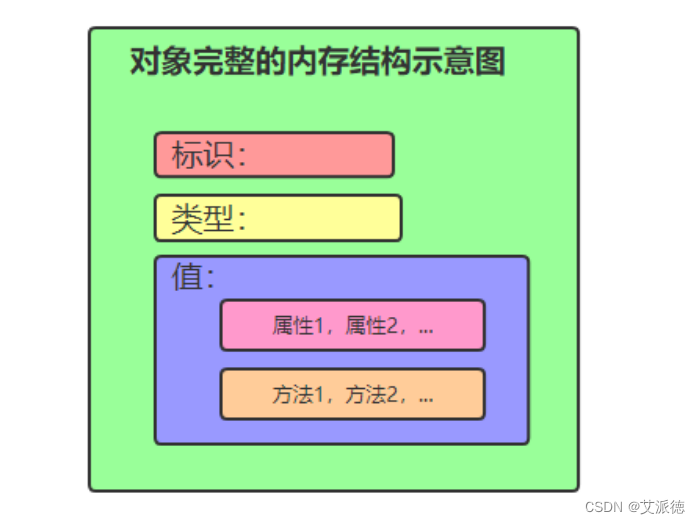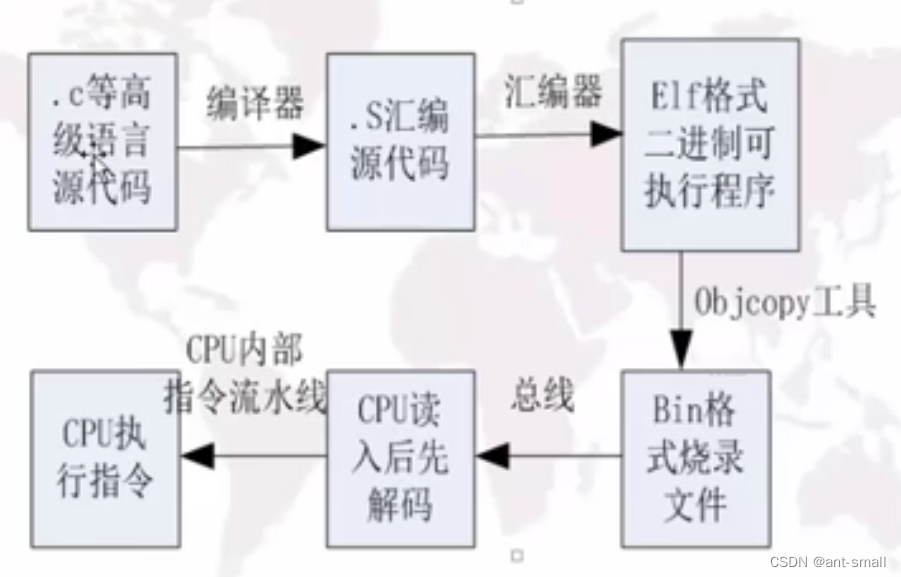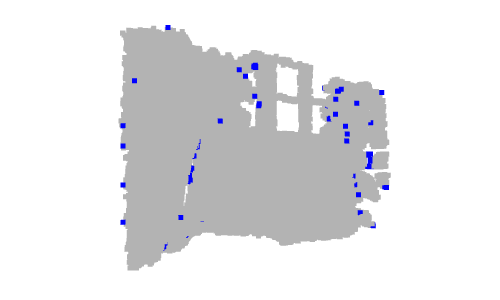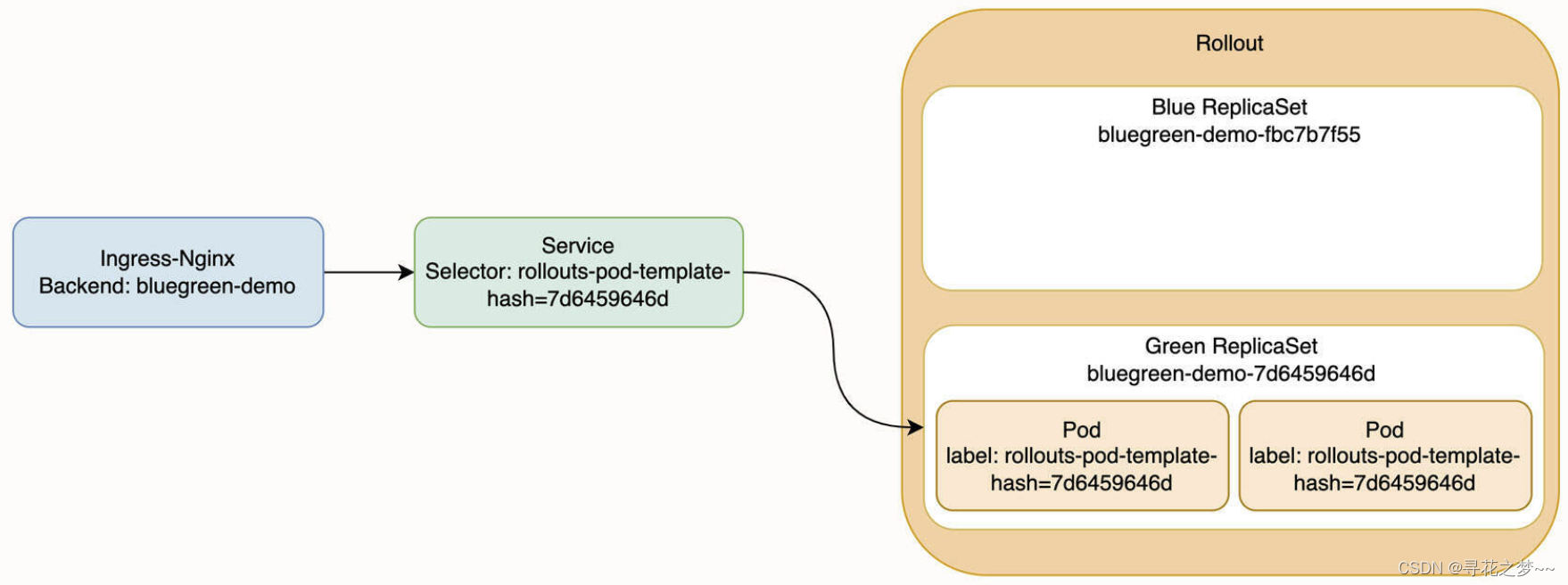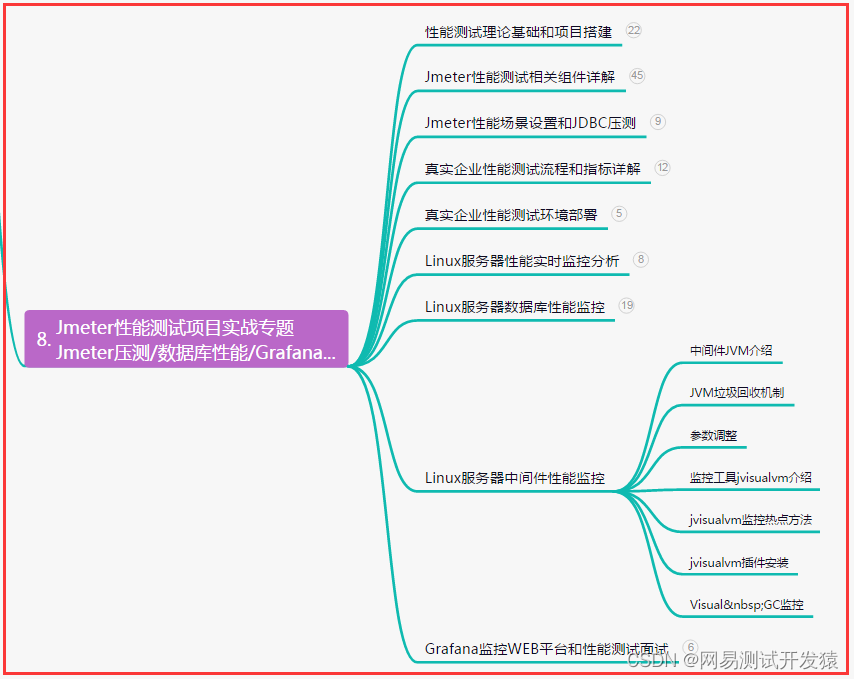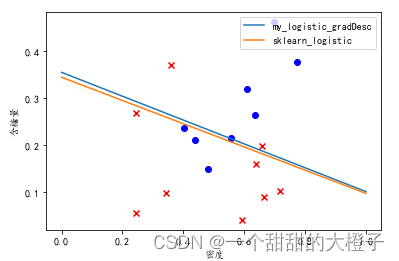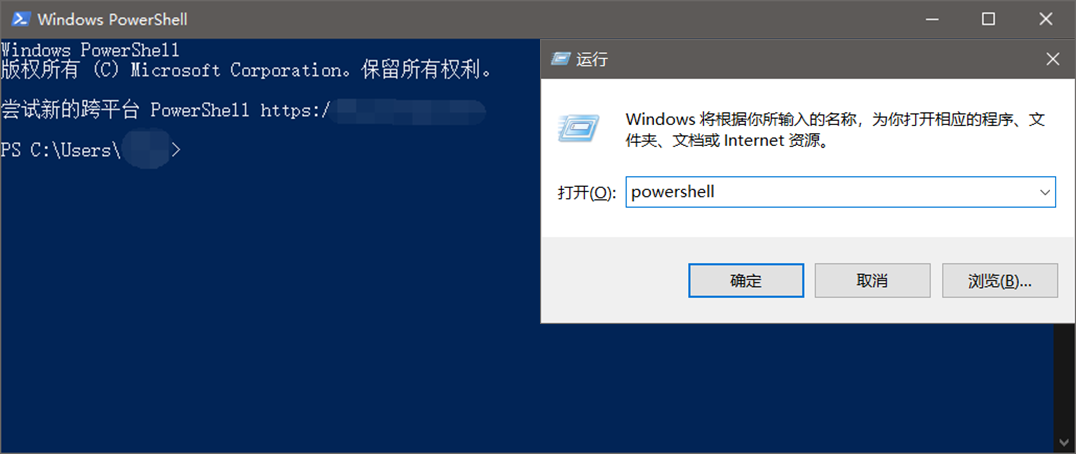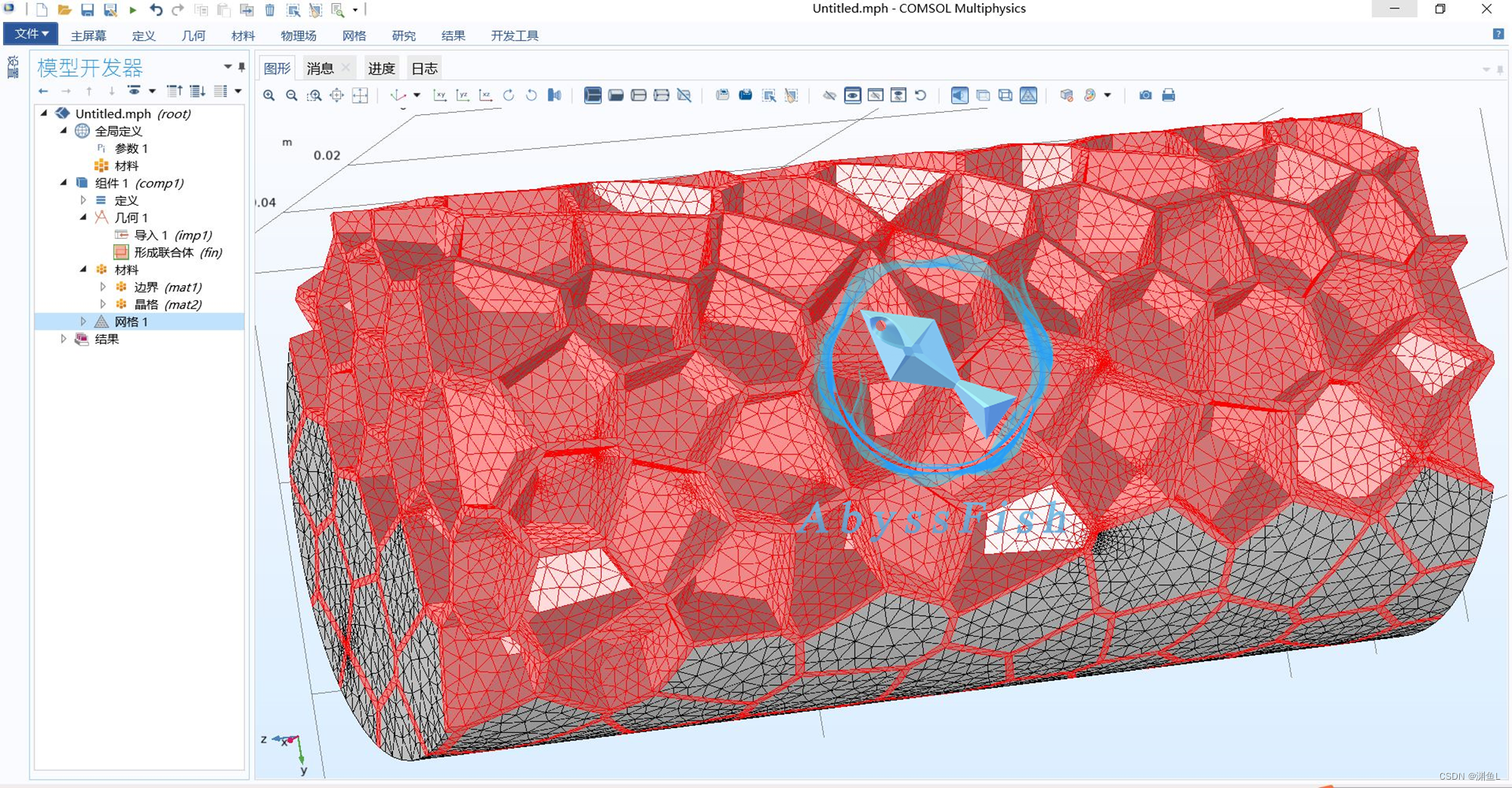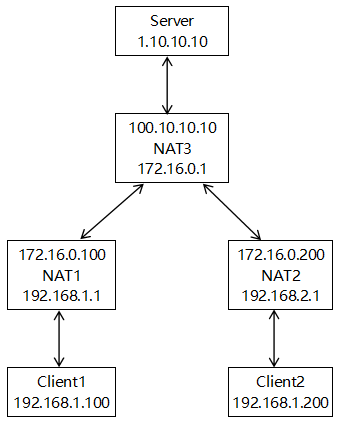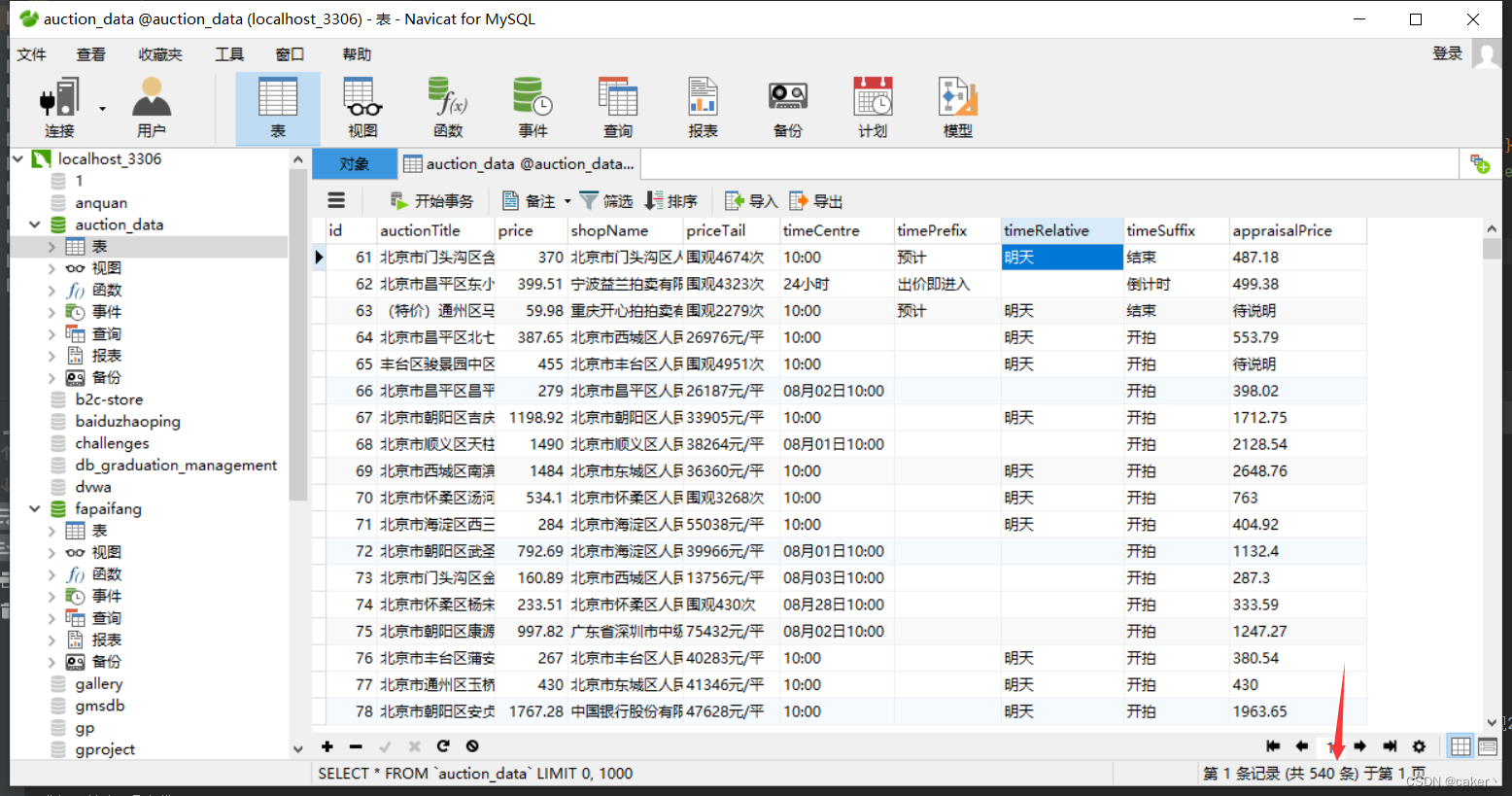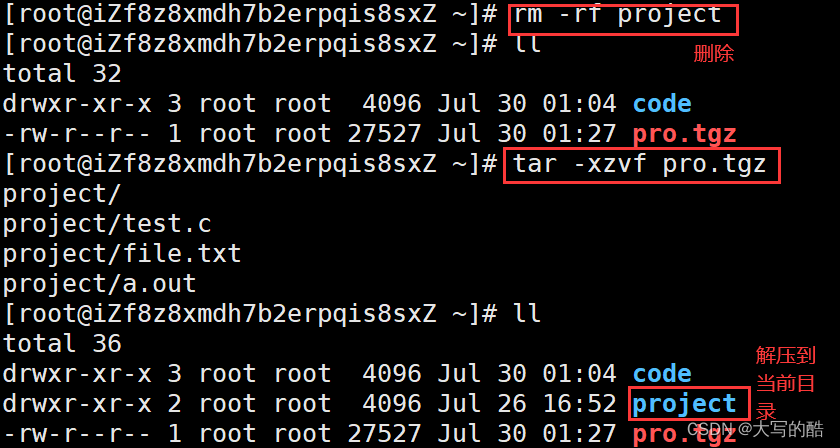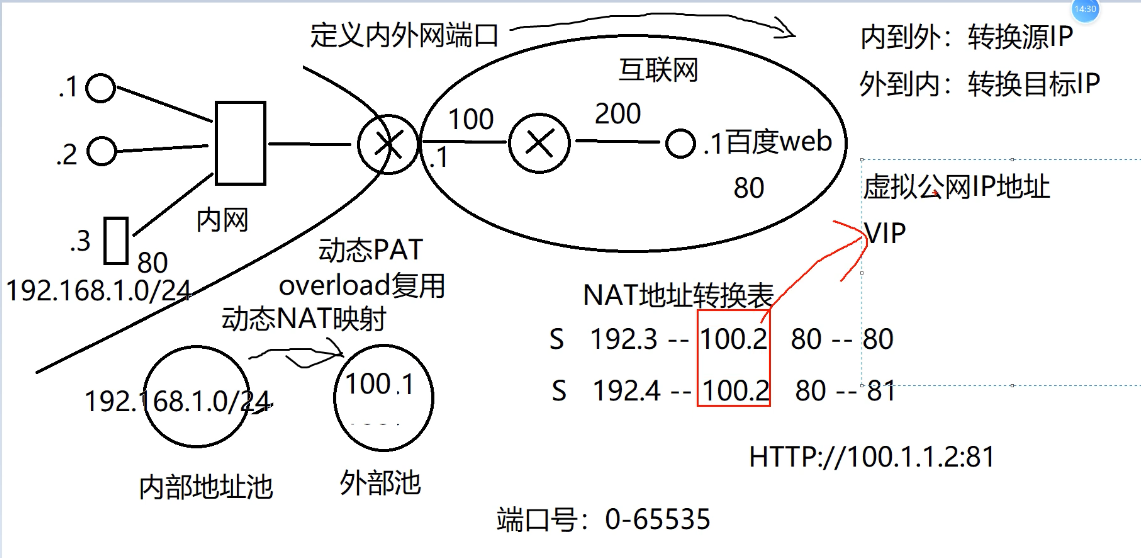string
- string类“登场”
- string类 - 了解
- string类的常用接口
- 常见构造
- 容量操作
- 访问及遍历操作
- 迭代器
- 分类
- 作用
- 增删查改操作
- 非成员函数
- string类的实现
- string类重要的方法实现分析介绍
- 构造函数
- 拷贝构造函数
- 赋值运算符重载
- 总结
- string类整体实现代码
- 写时拷贝(了解)
- vs2019中的buffer数组
严格的来说string出现的时候是早于STL
string类“登场”
在C语言中,字符串是以’\0’结尾的一些字符的集合,为了方便C标准库提供了一些str系列的函数。但是库函数和字符串是分割开的,不符合OOP(面向对象编程)思想,而且底层空间需要自己管理,不注意可能就会出现越界。
为了解决上述问题,所以出现了string类。
string类 - 了解
- string是表示字符串的类
- 该类的接口和常规容器的接口基本相同,并且添加了一些专门用来操作string的常规操作。
string类的常用接口
使用接口时要包含头文件
#include <string>
常见构造
| (constructor)函数名称 | 功能说明 |
|---|---|
| string() | 构造空的string类对象,即空字符串 |
| string(const char* s) | 用C-string来构造string类对象 |
| string(const string& s) | 拷贝构造函数 |
| string(size_t n, char c) | string类对象中包含n个字符 |
test:
void Test_string()
{
string s1;
string s2("hello");
string s3(s2);
string s4(10, 'x');
}
容量操作
| 函数名称 | 功能说明 |
|---|---|
| size | 返回字符串有效字符长度 |
| capacity | 返回空间总大小 |
| empty | 检测字符串释放为空串 |
| clear | 清空有效字符(改变size,不改变capacity) |
| reserve | 为字符串开空间 |
| resize | 将有效字符个数改成n个,多出的空间用字符’c’填充。没有’c’,用0填充 |
test:
void Test_string()
{
string s1("hello");
cout << s1.size() << endl;
cout << s1.capacity() << endl;
cout << s1.empty() << endl;
s1.clear();
cout << "new1_size:" << s1.size() << endl;
cout << "new1_capacity:" << s1.capacity() << endl;
s1.reserve(10);
cout << "new2_size:" << s1.size() << endl;
cout << "new2_capacity:" << s1.capacity() << endl;
s1.reserve(50);
cout << "new3_size:" << s1.size() << endl;
cout << "new3_capacity:" << s1.capacity() << endl;
s1.resize(60, 'x');
cout << s1 << endl;
cout << "new4_size:" << s1.size() << endl;
cout << "new4_capacity:" << s1.capacity() << endl;
s1.resize(70);
cout << s1 << endl;
cout << "new5_size:" << s1.size() << endl;
cout << "new5_capacity:" << s1.capacity() << endl;
}
访问及遍历操作
| 函数名称 | 功能说明 |
|---|---|
| operator[] | 返回pos位置的字符 |
| begin + end | 迭代器,左闭右开 |
| rbegin + rend | 反向迭代器,左闭右开 |
| 范围for | 遍历方式 |
test1: operator[]
void Test_string()
{
string s1("hello");
//operator[]重载了两个
//char& operator[] (size_t pos);
//const char& operator[] (size_t pos) const;
for (size_t i = 0; i < s1.size(); i++)
{
s1[i]++;
cout << s1[i] << " ";
}
cout << endl;
const string s2("world");
for (size_t i = 0; i < s2.size(); i++)
{
//s2[i]++; //error
cout << s2[i] << " ";
}
cout << endl;
}
test2: 迭代器,反向迭代器,范围for
void Test_string()
{
string s1("hello");
//迭代器
string::iterator it = s1.begin();
while (it != s1.end())
{
cout << *it << " ";
++it;
}
cout << endl;
//反向迭代器
string::reverse_iterator rit = s1.rbegin();
while (rit != s1.rend())
{
cout << *rit << " ";
++rit;
}
cout << endl;
//const迭代器
const string s2("world");
string::const_iterator c_it = s2.begin();
while (c_it != s2.end())
{
cout << *c_it << " ";
++c_it;
}
cout << endl;
//const反向迭代器
string::const_reverse_iterator c_rit = s2.rbegin();
while (c_rit != s2.rend())
{
cout << *c_rit << " ";
++c_rit;
}
cout << endl;
//范围for
for (auto ch : s2)
{
cout << ch << " ";
}
cout << endl;
}
迭代器
在上面的例子中,展现了迭代器的一些作用
分类
| 分类 | 迭代器 | 反向迭代器 |
|---|---|---|
| 普通迭代器 | iterator | reverse_iterator |
| const迭代器 | const_iterator | const_reverse_iterator |
作用
- 迭代器提供一种统一的方式访问和修改容器的数据
- 算法通过迭代器去处理容器的数据
增删查改操作
| 函数名称 | 功能说明 |
|---|---|
| push_back | 尾插字符 |
| append | 在字符串后追加字符串 |
| operator+= | 追加字符串str |
| c_str | 返回C格式字符串 |
| erase | 删除 |
| insert | 插入 |
| assign | 将内容分配给字符串 |
| find + npos | 从pos位置开始往后找字符,返回该字符在字符串中的位置 |
| rfind | 从pos位置开始往前找字符,返回该字符在字符串中的位置 |
| substr | 在str中从pos位置开始,截取n个字符,然后返回 |
test1: 增删改操作
void Test_string()
{
string s1 = "hello";
//void push_back (char c);
s1.push_back(' ');
cout << s1 << endl;
//append
//string& append(size_t n, char c);
s1.append(2, ' ');
//string& append(const char* s, size_t n);
s1.append("world!", 6);
cout << s1.c_str() << endl;
//operator+=
s1 += " 6666";
cout << s1.c_str() << endl;
//assign
s1.assign("xxxxxxxxxxyyxxxxx");
cout << s1 << endl;
//erase
//string& erase (size_t pos = 0, size_t len = npos);
//从第10个位置开始删除两个字符
s1.erase(10, 2);
cout << s1 << endl;
//全部删除
s1.erase();
cout << "erase after:" << s1 << endl;
//insert
s1.insert(0, "hello new !");
cout << s1 << endl;
//从s1第10个位置开始插入字符串的13个字符
s1.insert(10, "kang peng lei ....", 13);
cout << s1 << endl;
cout << s1.size() << endl;
s1.insert(s1.size(), 5, 'x');
cout << s1 << endl;
}
test2: 查找和substr
void Test_string()
{
string s1("hello kang peng lei!");
//c_str
char* c_s1 = new char[s1.size() + 1];
strcpy(c_s1, s1.c_str());
cout << s1.c_str() << endl;
cout << c_s1 << endl;
delete[] c_s1;
//find
string s2("https://legacy.cplusplus.com/reference/string/string/find/:");
//从第3个数开始匹配
size_t n2 = s2.find("://", 3);
cout << "pos2:" << n2 << endl;
string s3(".com/");
//从s2最开始的地方开始匹配s3
size_t n3 = s2.find(s3);
cout << "pos3:" << n3 << endl;
//从s2第2个位置匹配"om/re"的前三个字母
size_t n4 = s2.find("om/re", 2, 3);
cout << "pos4:" << n4 << endl;
//从第十个位置匹配':'
size_t n5 = s2.find(':', 10);
cout << "pos5:" << n5 << endl;
//substr
//string substr(size_t pos = 0, size_t len = npos) const;
string s4;
s4 = s2.substr(0, 5);
cout << "s4:" << s4 << endl;
//从5开始输出十个字符
string s5 = s2.substr(5, 10);
cout << "s5:" << s5 << endl;
string s6("Please, replace the vowels in this sentence by asterisks.");
size_t found = s6.find(" ");
size_t pos = 0;
//find + npos
while (found != string::npos)
{
cout << s6.substr(pos, found - pos) << " ";
pos = found;
found = s6.find(" ", found + 1);
}
cout << endl;
}
非成员函数
| 函数名称 | 功能说明 |
|---|---|
| operator>> | 流提取运算符重载 |
| operator<< | 流插入运算符重载 |
| getline | 获取一行字符串 |
| relational operators | 运算符重载(大小比较) |
test:
//getline
void Test_string()
{
string name;
getline(cin, name);
cout << "Hello, " << name << "!\n";
}
string类的实现
string类重要的方法实现分析介绍
构造函数
//带参构造函数
//string(const char* str)
// :_size(strlen(str))
// ,_capacity(_size + 1)
// ,_str(new char[_capacity])
//{
// strcpy(_str, str);
//}
//默认构造函数
//string()
// :_size(0)
// ,_capacity(1)
// ,_str(new char[1])
//{
// _str[0] = '\0';
//}
//构造函数
string(const char* str = "")
{
assert(str != nullptr);
_size = strlen(str);
_capacity = _size + 1;
_str = new char[_capacity];
memcpy(_str, str, _size + 1);
}
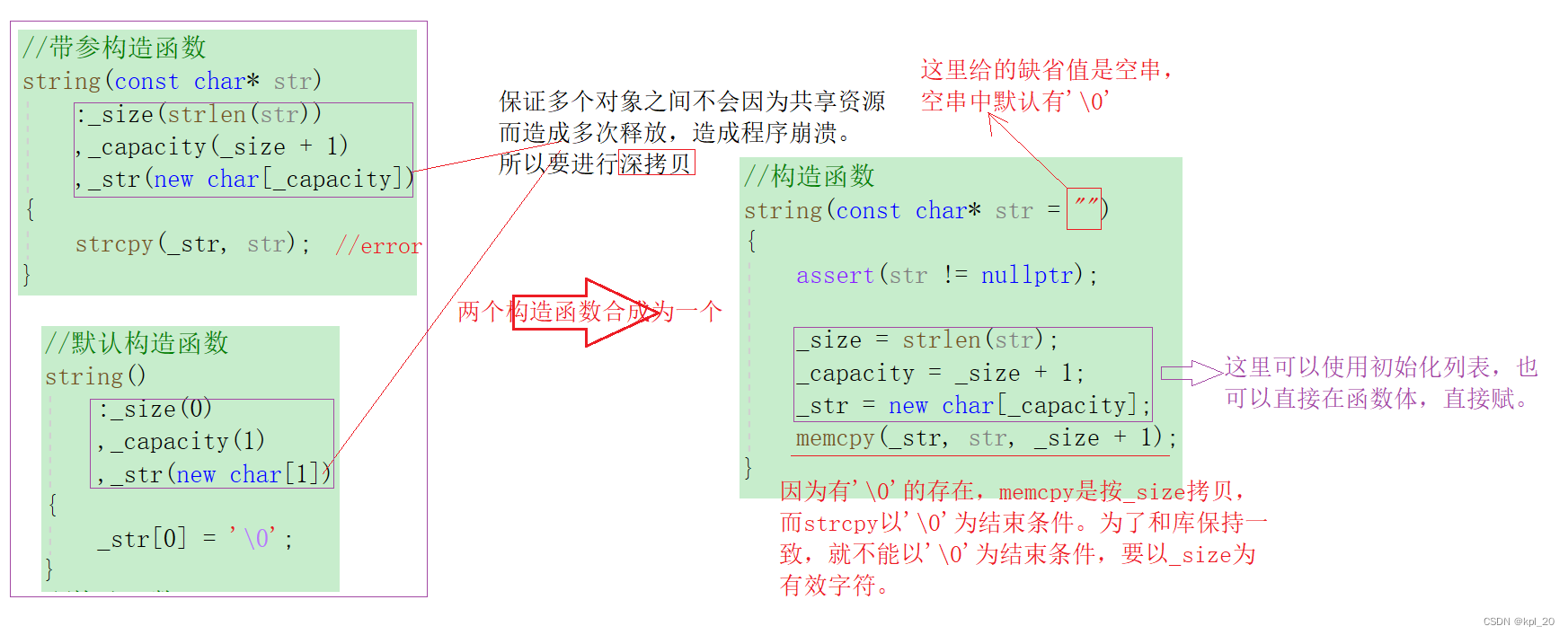
拷贝构造函数
//拷贝构造函数
string(const string& s)
{
_str = new char[s._capacity + 1];
memcpy(_str, s._str, s._size + 1);
_size = s._size;
_capacity = s._capacity;
}
//现代版本的拷贝构造函数
//有缺陷"hello\0world"
//而且要初始化,不初始化交换给tmp会出问题
/*string(const string& s)
:_str(nullptr)
, _size(0)
, _capacity(0)
{
//有缺陷是因为这里使用字符串拷贝的
string tmp(s._str);
swap(tmp);
}*/

赋值运算符重载
//运算符重载
//s1 = s2
/*string& operator=(const string& s)
{
if (this != &s)
{
char* tmp = new char[s._size + 1];
memcpy(tmp, s._str, s._size + 1);
delete[] _str;
_str = tmp;
_size = s._size;
_capacity = s._capacity;
}
return *this;
}*/
void swap(string& s)
{
std::swap(_str, s._str);
std::swap(_size, s._size);
std::swap(_capacity, s._capacity);
}
//string& operator=(const string& s)
//{
// if (this != &s)
// {
// string tmp(s);
//
// //this->swap(tmp)
// swap(tmp);
// }
// return *this;
//}
string& operator=(string tmp)
{
swap(tmp);
return *this;
}
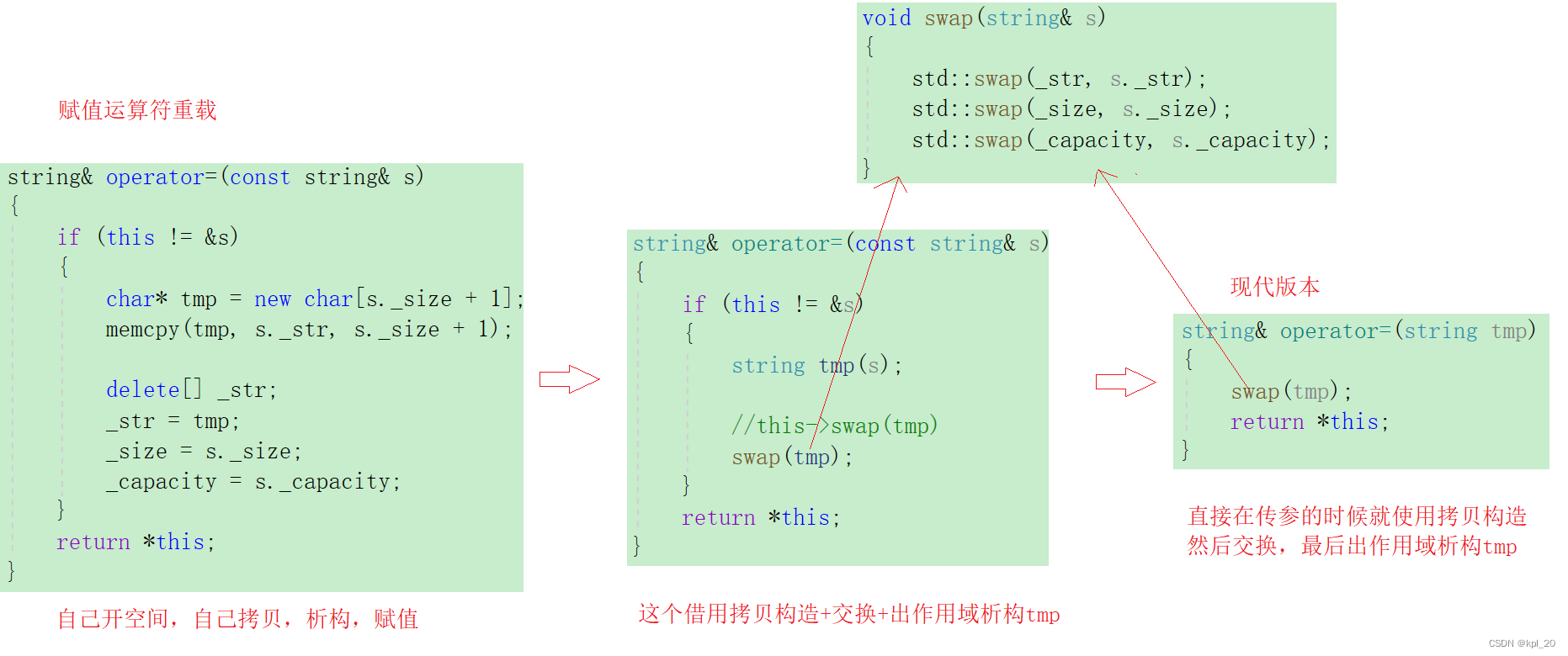
总结
因为涉及到开空间,所以构造函数,拷贝构造,赋值运算符重载,析构函数,都需要显示实现
string类整体实现代码
#include <iostream>
#include <assert.h>
using namespace std;
namespace kpl
{
class string
{
public:
const static size_t npos;
//迭代器和const迭代器
typedef char* iterator;
typedef const char* const_iterator;
iterator begin()
{
return _str;
}
iterator end()
{
return _str + _size;
}
const_iterator begin() const
{
return _str;
}
const_iterator end() const
{
return _str + _size;
}
带参构造函数
//string(const char* str)
// :_size(strlen(str))
// ,_capacity(_size + 1)
// ,_str(new char[_capacity])
//{
// strcpy(_str, str);
//}
默认构造函数
//string()
// :_size(0)
// ,_capacity(1)
// ,_str(new char[1])
//{
// _str[0] = '\0';
//}
//构造函数
string(const char* str = "")
{
assert(str != nullptr);
_size = strlen(str);
_capacity = _size + 1;
_str = new char[_capacity];
memcpy(_str, str, _size + 1);
}
//拷贝构造函数
string(const string& s)
{
_str = new char[s._capacity + 1];
memcpy(_str, s._str, s._size + 1);
_size = s._size;
_capacity = s._capacity;
}
//现在版本的拷贝构造函数
//有缺陷"hello\0world"
//而且要初始化,不初始化交换给tmp会出问题
/*string(const string& s)
:_str(nullptr)
, _size(0)
, _capacity(0)
{
//有缺陷是因为这里使用字符串拷贝的
string tmp(s._str);
swap(tmp);
}*/
//运算符重载
//s1 = s2
/*string& operator=(const string& s)
{
if (this != &s)
{
char* tmp = new char[s._size + 1];
memcpy(tmp, s._str, s._size + 1);
delete[] _str;
_str = tmp;
_size = s._size;
_capacity = s._capacity;
}
return *this;
}*/
void swap(string& s)
{
std::swap(_str, s._str);
std::swap(_size, s._size);
std::swap(_capacity, s._capacity);
}
//string& operator=(const string& s)
//{
// if (this != &s)
// {
// string tmp(s);
//
// //this->swap(tmp)
// swap(tmp);
// }
// return *this;
//}
string& operator=(string tmp)
{
swap(tmp);
return *this;
}
//析构函数
~string()
{
delete[] _str;
_str = nullptr;
_size = 0;
_capacity = 0;
}
//返回一个c类型的常量字符串
const char* c_str() const
{
return _str;
}
size_t capacity() const
{
return _capacity;
}
size_t size() const
{
return _size;
}
//重载[]
char& operator[](size_t pos)
{
assert(pos < _size);
return _str[pos];
}
const char& operator[](size_t pos) const
{
assert(pos < _size);
return _str[pos];
}
//扩容
void reserve(size_t n)
{
if (n > _capacity)
{
char* tmp = new char[n + 1];
memcpy(tmp, _str, _size + 1);
delete[] _str;
_str = tmp;
_capacity = n + 1;
}
}
void resize(size_t n, char ch = '\0')
{
if (n < _size)
{
_size = n;
_str[_size] = '\0';
}
else
{
//扩容
reserve(n);
for (size_t i = _size; i < n; i++)
{
_str[i] = ch;
}
_size = n;
_str[_size] = '\0';
}
}
void push_back(char ch)
{
if (_size == _capacity - 1)
{
reserve(_capacity == 1 ? 4 : 2 * _capacity);
}
_str[_size] = ch;
++_size;
_str[_size] = '\0';
}
void append(const char* str)
{
size_t len = strlen(str);
if (_size + len >= _capacity)
{
reserve(_size + len);
}
memcpy(_str + _size, str, len);
_size += len;
_str[_size] = '\0';
}
string& operator+=(char ch)
{
push_back(ch);
return *this;
}
string& operator+=(const char* str)
{
append(str);
return *this;
}
void insert(size_t pos, size_t n, char ch)
{
assert(pos < _size);
if (n + _size > _capacity - 1)
{
reserve(n + _size);
}
//挪动数据
//第一种方法
/*int end = _size;
while (end >= (int)pos)
{
_str[end + n] = _str[end];
--end;
}*/
//第二种方法
/*size_t end = _size;
while (end >= pos && end != npos)
{
_str[end + n] = _str[end];
--end;
}
for (size_t i = 0; i < n; i++)
{
_str[i + pos] = ch;
}
_size += n;*/
//第三种方法
size_t end = _size + n;
while (end >= pos + n)
{
_str[end] = _str[end - n];
--end;
}
for (size_t i = 0; i < n; i++)
{
_str[i + pos] = ch;
}
_size += n;
}
void insert(size_t pos, const char* str)
{
assert(pos <= _size);
size_t len = strlen(str);
if (_size + len > _capacity - 1)
{
reserve(len + _size);
}
size_t end = _size + len;
while (end >= pos + len)
{
_str[end] = _str[end - len];
--end;
}
for (size_t i = 0; i < len; i++)
{
_str[i + pos] = str[i];
}
_size += len;
}
void erase(size_t pos, size_t len = npos)
{
assert(pos <= _size);
if (len == npos || pos + len >= _size)
{
_str[pos] = '\0';
_size = pos;
}
else
{
size_t end = pos + len;
while (end <= _size)
{
_str[pos++] = _str[end++];
}
_size -= len;
}
}
size_t find(char ch, size_t pos = 0) const
{
assert(pos < _size);
for (size_t i = pos; i < _size; i++)
{
if (_str[i] == ch)
{
return i;
}
}
return npos;
}
size_t find(const char* str, size_t pos = 0) const
{
assert(pos < _size);
const char* ptr = strstr(_str + pos, str);
return ptr == nullptr ? npos : ptr - _str;
}
string substr(size_t pos = 0, size_t len = npos) const
{
assert(pos < _size);
size_t n = len;
if (len == npos || pos + len > _size)
{
n = _size - pos;
}
string tmp;
tmp.reserve(n);
//i从开始到结束要有n个数据加到tmp所以终止条件是pos+n
for (size_t i = pos; i < pos + n; i++)
{
tmp += _str[i];
}
return tmp;
}
void clear()
{
_str[0] = '\0';
_size = 0;
}
//运算符重载 < 第一种写法
bool operator<(const string& s) const
{
size_t n1 = 0;
size_t n2 = 0;
while (n1 < _size && n2 < s._size)
{
if (_str[n1] < s._str[n2])
{
return true;
}
else if (_str[n1] > s._str[n2])
{
return false;
}
else
{
n1++;
n2++;
}
}
return n1 == _size && n2 != s._size;
//return _size < s._size;
}
//第二种写法
/*bool operator<(const string& s) const
{
int ret = memcmp(_str, s._str, _size < s._size ? _size : s._size);
return ret == 0 ? _size < s._size : ret < 0;
}*/
bool operator==(const string& s) const
{
return _size == s._size && memcmp(_str, s._str, _size) == 0;
}
bool operator<=(const string& s) const
{
return *this < s || *this == s;
}
bool operator>(const string& s) const
{
return !(*this <= s);
}
bool operator>=(const string& s) const
{
return !(*this < s);
}
bool operator!=(const string & s) const
{
return !(*this == s);
}
private:
size_t _size;
size_t _capacity;
char* _str;
};
const size_t string::npos = -1;
//流插入和流提取运算符重载
ostream& operator<<(ostream& _cout, const string& s)
{
for (auto e : s)
{
_cout << e;
}
return _cout;
}
istream& operator>>(istream& _cin, string& s)
{
s.clear();
//读取一个字符
char ch = _cin.get();
while (ch == ' ' || ch == '\n')
{
ch = _cin.get();
}
//节约空间
char buf[128];
int i = 0;
while (ch != ' ' && ch != '\n')
{
buf[i++] = ch;
if (i == 127)
{
buf[i] = '\0';
s += buf;
i = 0;
}
ch = _cin.get();
}
if (i != 0)
{
buf[i] = '\0';
s += buf;
}
return _cin;
}
}
写时拷贝(了解)
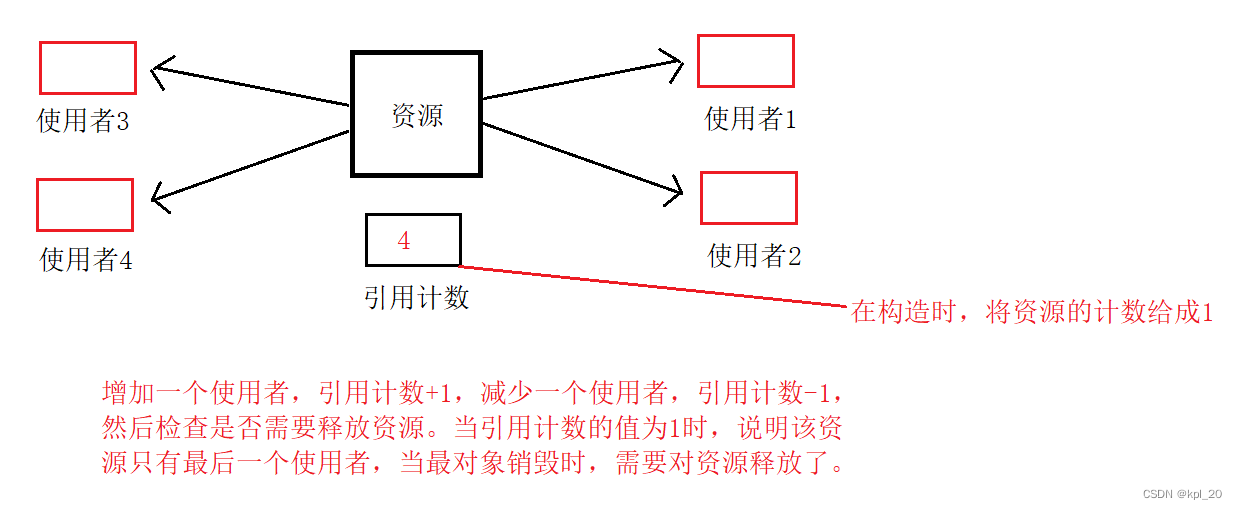
vs2019中的buffer数组



